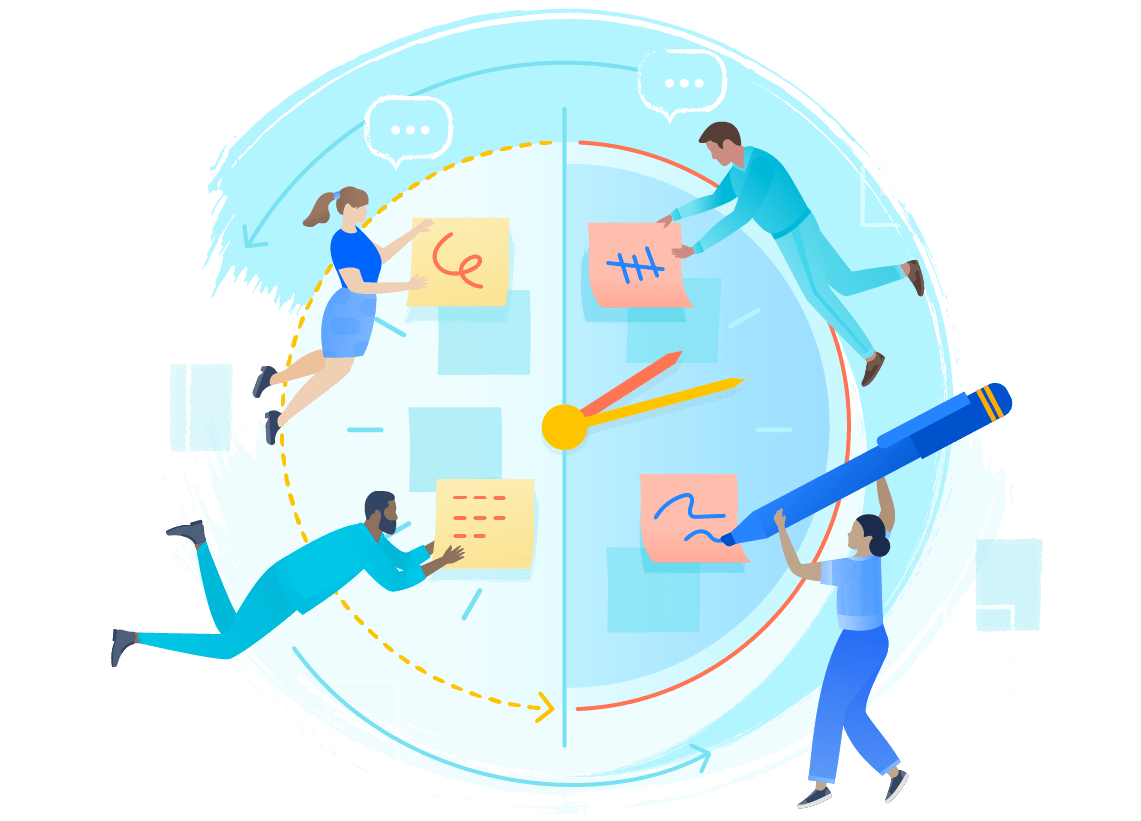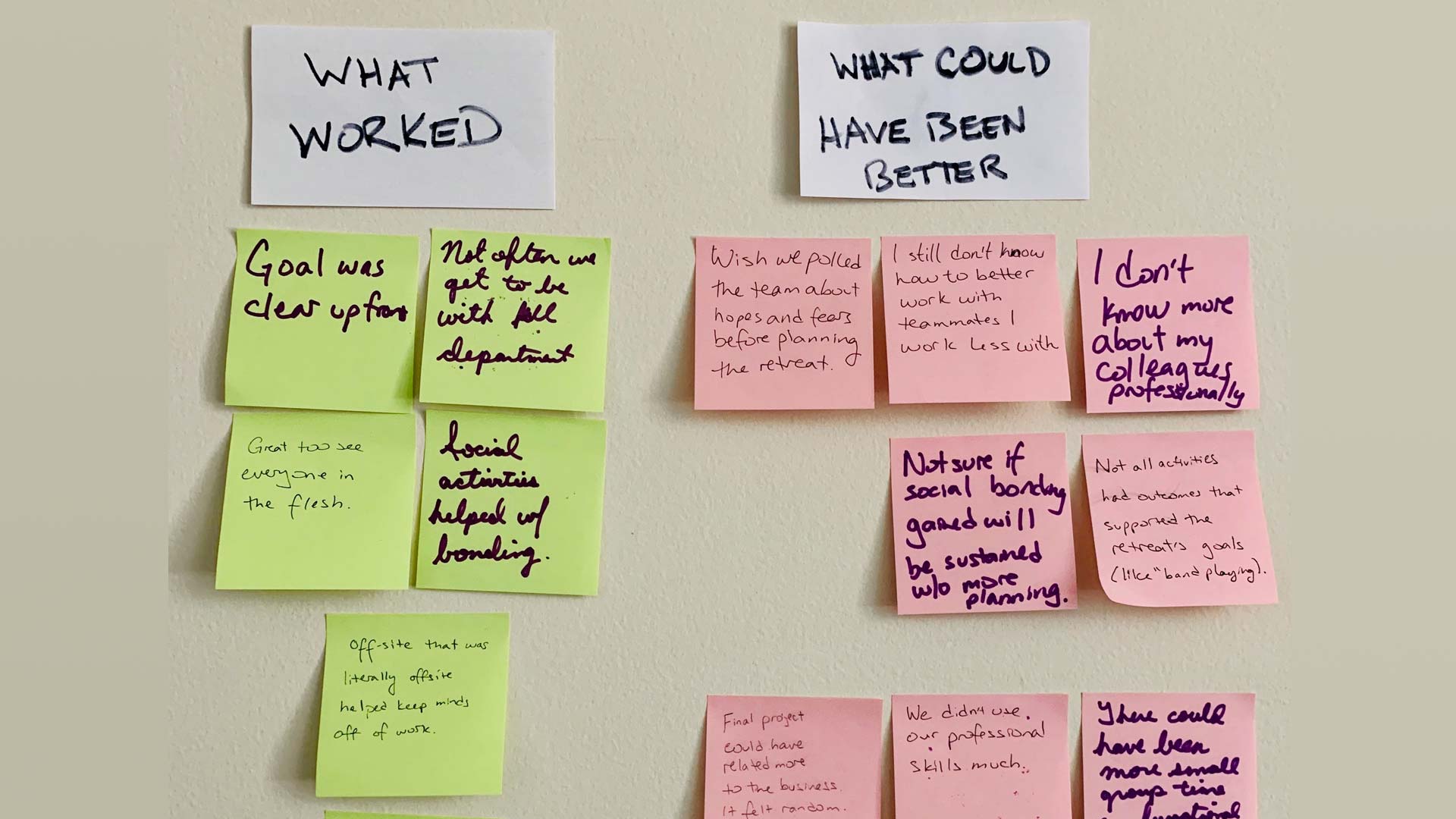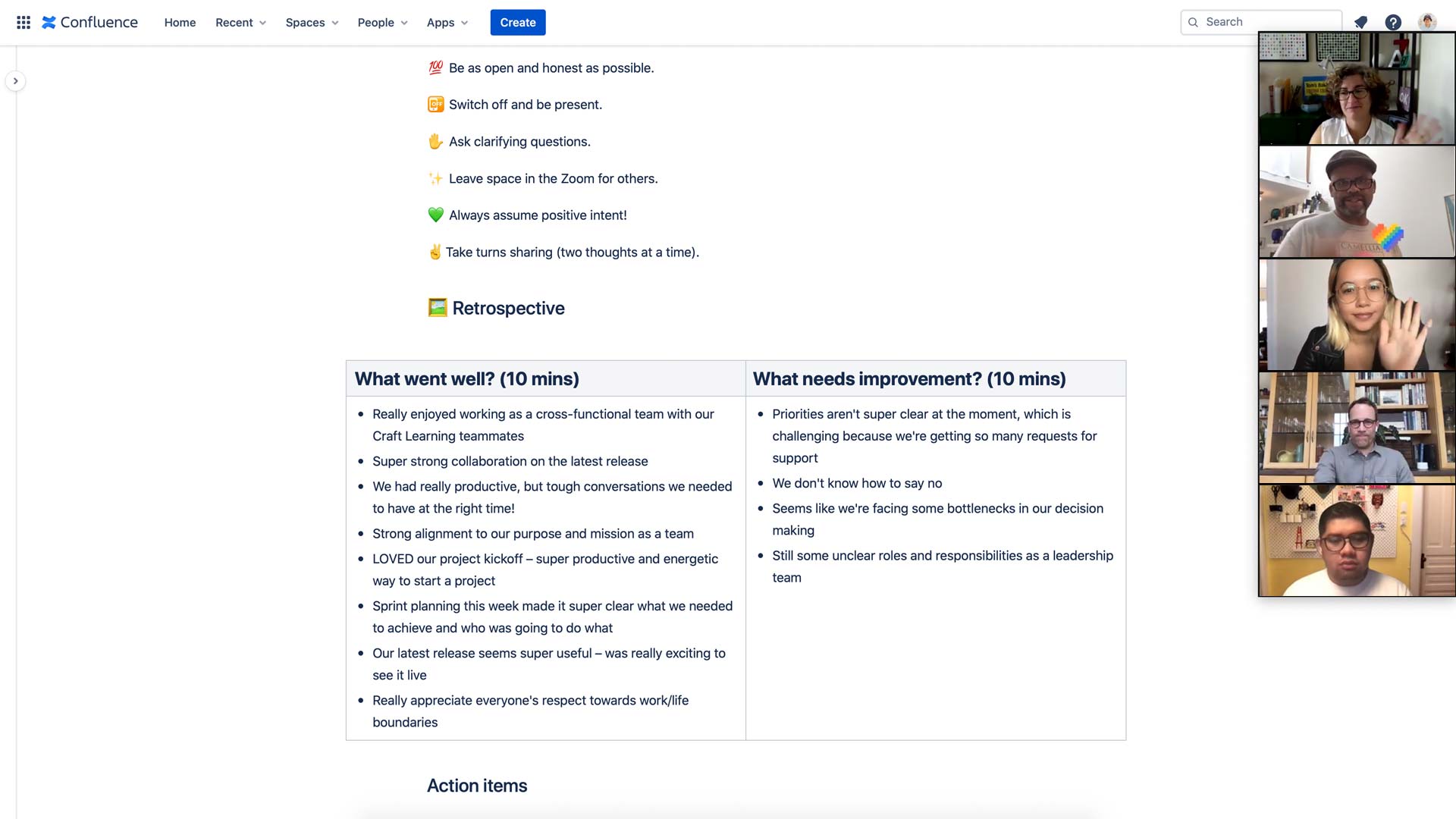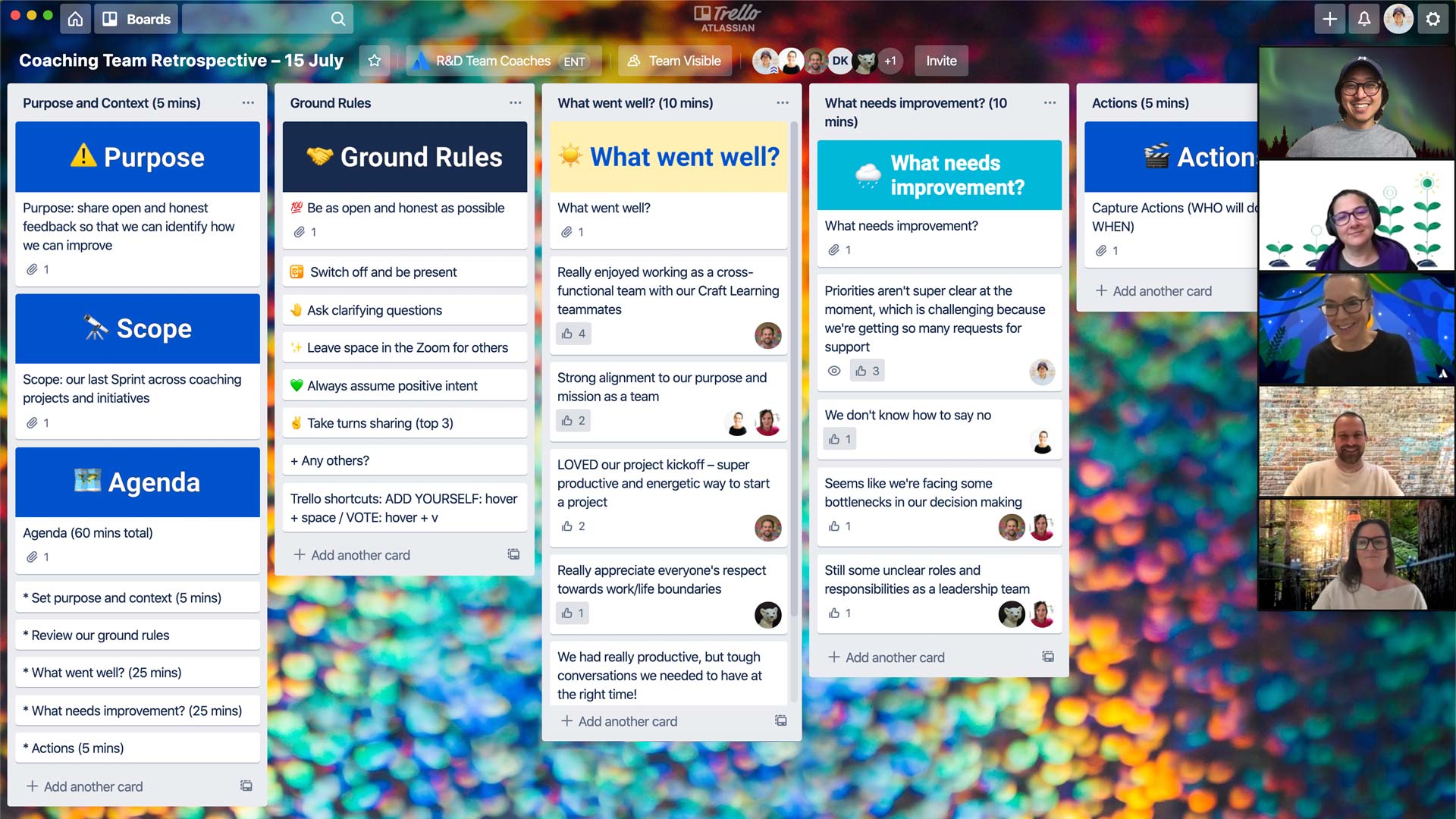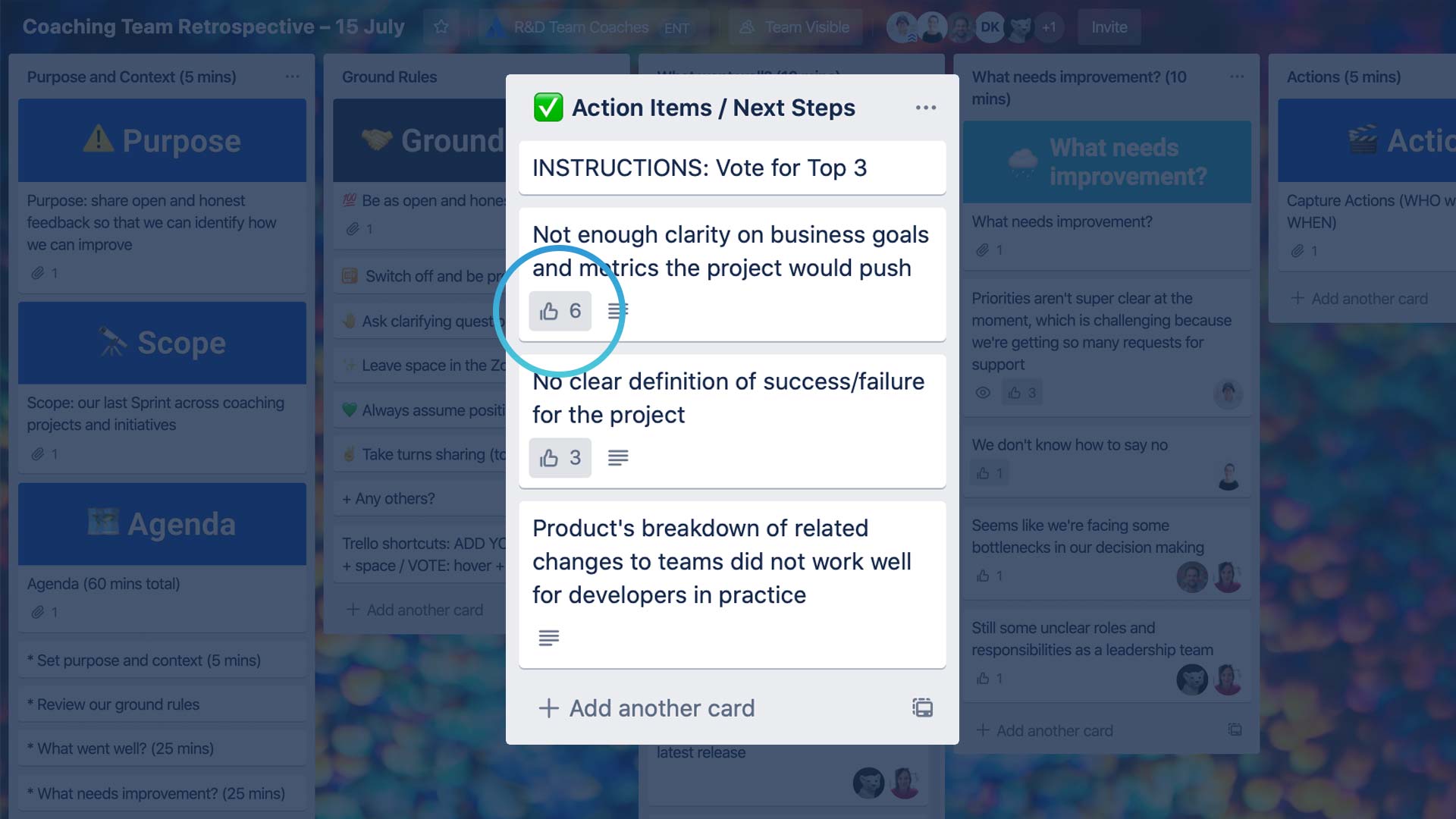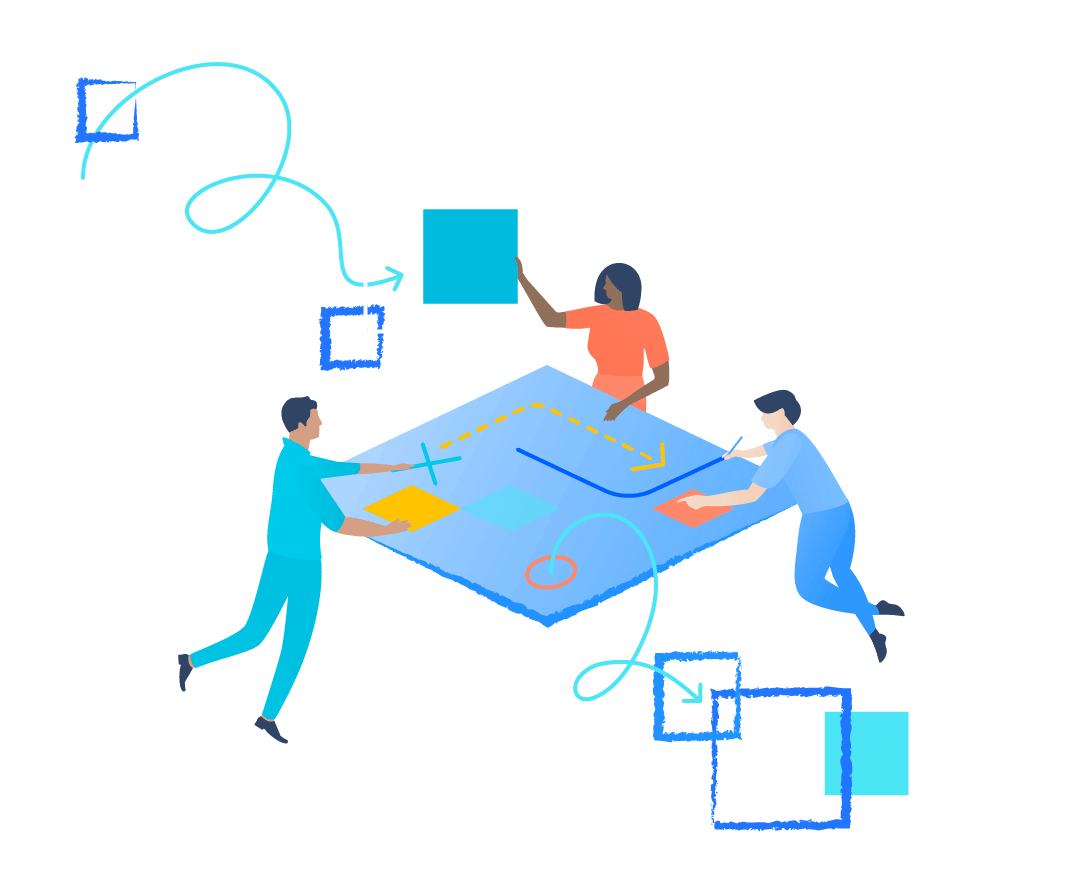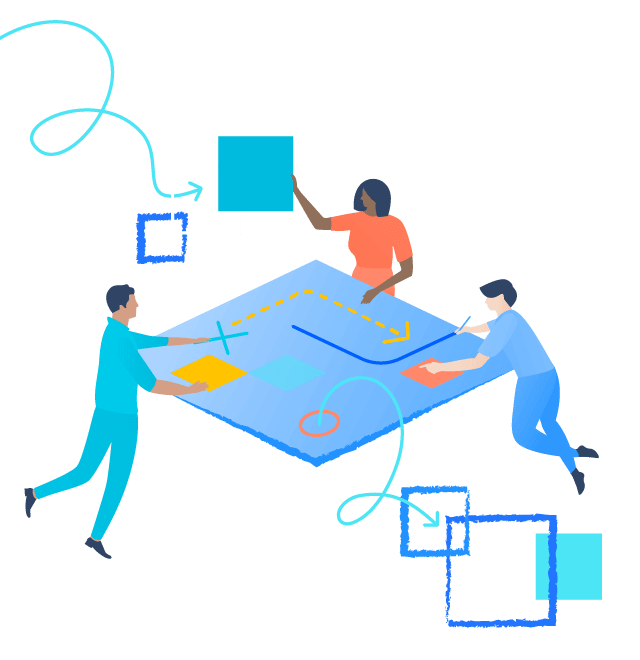Что такое ретроспектива спринта?
Ретроспектива спринта — это обзор, проводимый после спринта, который играет ключевую роль в методике Agile. Цель ретроспективы спринта — определить, что прошло успешно, а где возникли проблемы, а также выявить области, требующие улучшения.
Регулярные обзоры — важная часть совместной работы команды. Понимая, что работает, а что нет, можно улучшить процессы Agile и оптимизировать следующий спринт.
Кому следует присутствовать на собрании по ретроспективе спринта?
На собрании по ретроспективе спринта должны присутствовать владелец продукта, scrum-команда, scrum-мастер и заинтересованные стороны. Во время собрания по ретроспективе спринта полезно иметь в зале самые разные точки зрения. Все участники могут вместе проанализировать последний спринт и определить, какие изменения необходимо внести перед началом работы над следующей частью проекта.
Почему ретроспективы спринтов важны?
Проведение ретроспективы спринта позволяет сделать выводы из предыдущей работы и улучшить будущие спринты, что приведет к оптимизации scrum-спринтов и более качественным результатам. Вот некоторые преимущества использования ретроспектив спринтов.
- Обеспечение непрерывного совершенствования
- Укрепление совместной работы
- Способствование решению проблем
- Предотвращение повторения ошибок
- Повышение качества результатов
- Улучшение командного духа
Ретроспективы на практике
Стикеры команды с выездной ретроспективы.
Эта команда использовала Confluence, чтобы подвести итоги обсуждения в ходе ретроспективы.
Ретроспектива, транслируемая через Zoom, в ходе которой в Trello участники формулировали базовые правила, добавляли идеи и направляли обсуждение в нужное русло.
Что вам понадобится
Удаленно
Видеоконференция с возможностью демонстрировать экран
Цифровой инструмент для совместной работы (см. шаблоны)
Очно
Пространство для собрания
Доска или большой лист бумаги
Маркеры
Стикеры
Таймер
Рекомендуемые шаблоны
Пять шагов по успешному проведению собрания по ретроспективе спринта
Помимо использования шаблонов ретроспективы, для успешного проведения собрания по ретроспективе спринта вы можете выполнить несколько простых шагов. Все участники команды должны чувствовать, что их вклад в проведение собрания ценен. Собрав отзывы, вы можете проанализировать их и создать списки задач для внесения улучшений.
Вот 5 шагов по успешному проведению собрания по ретроспективе спринта.
Шаг 1. Задайте тон
При проведении ретроспективы спринта первым делом задайте тон. Цель планирования спринта заключается в том, чтобы собрать различные точки зрения и использовать их для постановки целей и улучшения процессов Agile. На обзоре итогов спринта каждый участник должен чувствовать, что имеет право голоса, поэтому задайте соответствующий тон с самого начала собрания.
Вам нужно побудить людей делиться отзывами и ценными идеями во время ретроспективы спринта. Сосредоточьтесь на моментах, которые можно усовершенствовать, а не вините людей за ошибки. Позвольте всем общаться открыто и честно.
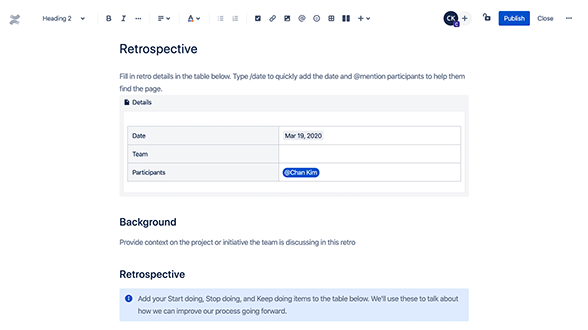
Пример: Confluence
Проводите этот сценарий удаленно? Используйте бесплатный шаблон ретроспективы, чтобы направлять беседу в нужное русло и фиксировать данные, полученные в результате этого семинара.
Шаг 2. Соберите обратную связь
После того как вы зададите тон и все поймут, какая информация вам нужна, можно приступать к сбору обратной связи от участников команды. Ретроспектива по модели четырех «Ч» — это один из способов получить обратную связь, спросив, что понравилось, что не понравилось, чему научились и чего не хватало во время спринта. Если люди затрудняются предоставить подробный отзыв, эти четыре «Ч» станут отправной точкой.
Собрать обратную связь от всех участников ретроспективы спринта можно различными способами. Можно провести групповое обсуждение, если все на это согласны. Вы также можете попросить участников команды пройти опросы или отправить анонимные отзывы, которые можно использовать для улучшения следующего спринта.
Совет. Адаптируйте этот список к своим потребностям
Меняйте правила с учетом уникальных потребностей команды. Добавьте все, что, по вашему мнению, поможет вашей команде стать лучше.
Совет. Создайте безопасное пространство
Решите, как нужно обсудить информацию после сценария. Будет ли она передана руководству? Возможно, вам следует придерживаться правила Чатем-Хауса.
Шаг 3. Извлечение выводов
Собрать отзывы во время ретроспективы спринта — это еще не все. После этого их нужно пустить в дело. Проанализируйте полученные отзывы, чтобы найти закономерности и тенденции, которые помогут вам лучше понять команду и предыдущий спринт.
Эта аналитика — ключ к постановке целей, поэтому предложите участникам объединить усилия и озвучивать любые ценные замечания, которые у них могут появиться. Мы уже упоминали, как важно получить разные точки зрения на собрании по обзору итогов спринта, и при извлечении выводов это становится очевидным.
Шаг 4. Создание списка задач
Когда вы получите сведения о своей Agile-команде и последнем спринте, их можно будет превратить в практические задачи. На этом шаге можно начать ставить цели и определять, какие изменения стоит внести в будущие спринты.
Очень важно задать SMART-цели — конкретные, измеримые, достижимые, уместные и ограниченные по времени. Постановка SMART-целей имеет решающее значение для достижения успеха и помогает компании выполнить намеченное и получать актуальные результаты.
Совет. Убедитесь, что никого не проигнорировали
Если обсуждением полностью завладели один или два человека, ведущий должен вмешаться и дать слово другим участникам, прежде чем переходить к следующему этапу.
Шаг 5. Завершение ретроспективы
Теперь, когда вы извлекли уроки из предыдущего спринта и предусмотрели улучшения для следующего, можно подвести итоги собрания по ретроспективе спринта. Кратко обрисуйте основные выводы собрания, поблагодарите всех активных участников и дайте всем понять, что еще один этап работы пройден.
Чтобы усилия не пропали даром, в конце собрания по ретроспективе спринта у вас должен быть готов четкий план. Понимание того, как вы будете внедрять изменения, — это ключевой результат собраний по спринту.
Совет. Обновите рабочие процессы
Если каким-либо действиям соответствуют задачи в Jira, добавьте на страницу ссылки на них, чтобы упростить проверку статуса задачи.
Уделяйте время действиям, определенным на ретроспективе, например на стендапах или при еженедельном обмене новостями о статусе команды.
Идеи для собраний по ретроспективе спринта
Руководителю Agile-команды не стоит ограничиваться поверхностным изучением досок Scrum — вам нужно направлять ход собраний, чтобы извлекать ценные выводы. Изучите примеры ретроспектив спринтов, чтобы найти идеи для следующего собрания по ретроспективе спринта, выработать оптимальный процесс и собрать полезные отзывы.
Использование метода четырех «Ч» может побудить участников команды поделиться своим мнением и быстро дать вам представление о том, что прошло хорошо, а что нужно улучшить.
Кроме того, вы можете организовать обсуждение на следующей ретроспективе спринта по методике «радость/грусть/гнев». Просто подготовьте три столбца, которые станут шаблоном для отзывов вашей команды.
- Грусть: что вас разочаровало? Могли ли вы лучше проявить себя в каких-либо областях?
- Гнев: что выбило вас из колеи? Быть может, что-то помешало вам проявить себя наилучшим образом?
Радость: какие моменты проекта вам больше всего понравились? Что, на ваш взгляд, прошло хорошо?
Есть множество способов стимулировать обсуждение во время ретроспективы спринта, поэтому не бойтесь экспериментировать, чтобы сохранить динамичность собраний. Помните, что некоторые команды предпочитают давать отзывы анонимно, и в этом нет ничего плохого. Ретроспективы спринтов можно адаптировать в формат, который подойдет вашей команде.
Идеи для собраний по ретроспективе спринта
Поначалу ретроспективы спринтов могут казаться неподъемными, но это достаточно простая концепция. Их можно проводить по шаблону ретроспективы спринта либо по пяти шагам, предложенным в этом руководстве. Если вы собираете отзывы, извлекаете из них выводы и внедряете изменения, вы все делаете правильно.
Каждая ретроспектива спринта начинается с успешного спринта. В Jira предусмотрено несколько ключевых функций, которые помогут вам организовать успешные спринты, в том числе:
- Бэклоги. Бэклоги позволяют перечислить всю работу, связанную с проектом или инициативой. Ее можно разбивать на отдельные спринты, которые обычно длятся по 2 недели.
- Доски. С помощью досок Jira можно разделить большой проект на более посильные части, чтобы планировать спринты и гарантировать быструю поставку результатов.
- Хронологии. В обзоре хронологии проекта указаны соответствующие рабочие задачи, зависимости и релизы, что помогает согласовывать действия команды и заинтересованных сторон.
Jira облегчает для Agile-команд визуализацию и отслеживание спринтов, а также управление ими. С Jira ваш следующий спринт станет проще, что обеспечит своевременную поставку результатов. Попробуйте Scrum-доски Jira и узнайте, как можно оптимизировать работу Agile-команды с помощью Jira.
Ретроспектива спринта: часто задаваемые вопросы
Какие трудности обычно возникают при ретроспективе спринта?
Отсутствие обратной связи — одна из самых больших потенциальных проблем ретроспективы спринта. Если люди не ведут себя открыто или не могут предоставить подробные отзывы, сложно определить, что прошло хорошо, а что нет. Участники будут активнее делиться мнениями, если вы подготовите простую структуру ретроспективы спринта, например с помощью метода «радость/грусть/гнев» и метода четырех «Ч». Или же можно попробовать собрать данные анонимно.
Кроме того, старайтесь не заострять внимание на разовых ошибках или успехах. Цель ретроспективы спринта — сделать следующий спринт лучше, поэтому не ориентируйтесь на отзывы, которые не повлияют на оставшуюся часть проекта.
Сколько должно длиться собрание по ретроспективе спринта?
Продолжительность собрания по ретроспективе спринта зависит от продолжительности самого спринта. Ретроспективы могут длиться как 45 минут, так и 3 часа — все зависит от того, какой спринт вы провели. Как бы вам ни хотелось быть эффективным во всех своих начинаниях, важно дать своей команде достаточно времени для содержательного обсуждения и достижения прогресса во время ретроспективы спринта.
Какие вопросы следует задавать во время ретроспективы спринта?
Есть несколько способов стимулировать обсуждение во время ретроспективы спринта. Можно использовать метод четырех «Ч», чтобы спросить участников о том, что им понравилось, чему они научились, что не понравилось и чего не хватало во время спринта. Либо же можно использовать методику «радость/грусть/гнев», чтобы подробнее изучить последний спринт. Вот некоторые вопросы, которые полезно будет задать во время ретроспективы спринта.
- Что получилось?
- Что пошло не так?
- Чему вы научились?
Что мы можем изменить?
Изучите другие сценарии
От наших команд — вашим
Подпишитесь на нашу ежемесячную информационную рассылку и будьте в курсе новейших сценариев, советов и рекомендаций.
